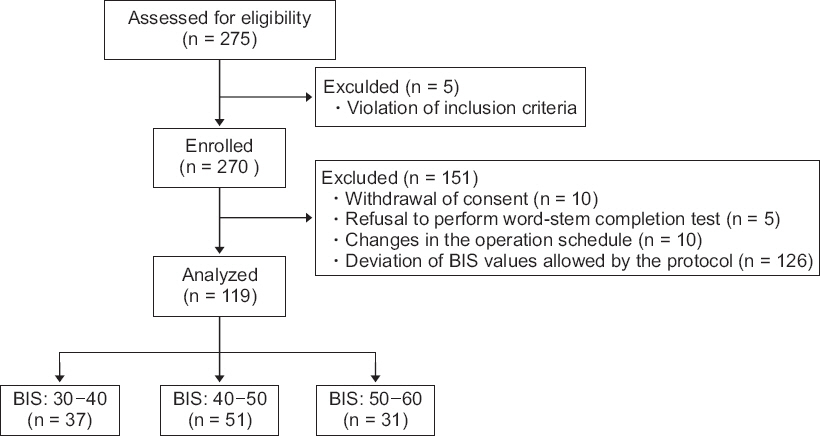Anesth Pain Med.
2018 Oct;13(4):388-393. 10.17085/apm.2018.13.4.388.
Investigation into memory formation according to the level of hypnotic depth using process dissociation
- Affiliations
-
- 1Department of Anesthesiology and Pain Medicine, Asan Medical Center, University of Ulsan College of Medicine, Seoul, Korea. byungmoonchoi7@gmail.com
- 2Department of Clinical Pharmacology and Therapeutics, Asan Medical Center, University of Ulsan College of Medicine, Seoul, Korea.
- KMID: 2435996
- DOI: http://doi.org/10.17085/apm.2018.13.4.388
Abstract
- BACKGROUND
Process dissociation procedure has been used to evaluate explicit and implicit memories. Two process-dissociation measurement models are described.
METHODS
This prospective study evaluated intraoperative memory formation in Korean patients undergoing elective surgery under general anesthesia and its relation to the depth of hypnotic state. A total of 270 patients enrolled were randomly assigned to three groups based on Bispectral Index (BIS) values in the following ranges: 30 to 40, BIS 40 to 50, and BIS 50 to 60 according to the level of hypnotic depth induced by propofol or sevoflurane during the presentation of wordlists. When the level of hypnotic depth was maintained at the target BIS range, words were played for 15 minutes via headphones to patients. Within 24 hours after the word presentation, memory was assessed using an auditory word stem completion test. The probability of explicit and implicit memory was calculated using original and extended measurement models. Brice interviews were performed within 1 and 24 hours after surgery.
RESULTS
A total of 119 patients who did not deviate from the target BIS range were included in the analysis. The 95% confidence interval (CI) of the probability of occurrence of implicit memory evaluated by the original model did not include zero. However, when the extension model was used, 0 was included in the 95% CI. Explicit memory evaluated via Brice interviews did not occur in any group.
CONCLUSIONS
When BIS was maintained in the range of 30 to 60 during surgery, no explicit or implicit memory was observed.
Keyword
MeSH Terms
Figure
Reference
-
REFERENCE
1. Squire LR, Zola SM. Structure and function of declarative and nondeclarative memory systems. Proc Natl Acad Sci U S A. 1996; 93:13515–22. DOI: 10.1073/pnas.93.24.13515.2. Jacoby LL. A process dissociation framework:separating automatic from intentional uses of memory. J MEM LANG. 1991; 30:513–41. DOI: 10.1016/0749-596X(91)90025-F.3. Ghoneim MM. Awareness during anesthesia. Anesthesiology. 2000; 92:597–602. DOI: 10.1097/00000542-200002000-00043. PMID: 10691248.4. Brice DD, Hetherington RR, Utting JE. A simple study of awareness and dreaming during anaesthesia. Br J Anaesth. 1970; 42:535–42. DOI: 10.1093/bja/42.6.535. PMID: 5423844.5. Lubke GH, Kerssens C, Phaf H, Sebel PS. Dependence of explicit and implicit memory on hypnotic state in trauma patients. Anesthesiology. 1999; 90:670–80. DOI: 10.1097/00000542-199903000-00007. PMID: 10078666.6. Lubke GH, Kerssens C, Gershon RY, Sebel PS. Memory formation during general anesthesia for emergency cesarean sections. Anesthesiology. 2000; 92:1029–34. DOI: 10.1097/00000542-200004000-00020. PMID: 10754622.7. Kerssens C, Ouchi T, Sebel PS. No evidence of memory function during anesthesia with propofol or isoflurane with close control of hypnotic state. Anesthesiology. 2005; 102:57–62. DOI: 10.1097/00000542-200501000-00012. PMID: 15618787.8. Iselin-Chaves IA, Willems SJ, Jermann FC, Forster A, Adam SR, Van der Linden M. Investigation of implicit memory during isoflurane anesthesia for elective surgery using the process dissociation procedure. Anesthesiology. 2005; 103:925–33. DOI: 10.1097/00000542-200511000-00005. PMID: 16249665.9. Buchner A, Erdfelder E, Vaterrodt-Plünnecke B. Toward unbiased measurement of conscious and unconscious memory processes within the process dissociation framework. J Exp Psychol Gen. 1995; 124:137–60. DOI: 10.1037/0096-3445.124.2.137. PMID: 7782736.10. Hadzidiakos D, Horn N, Degener R, Buchner A, Rehberg B. Analysis of memory formation during general anesthesia (Propofol/Remifentanil) for elective surgery using the process-dissociation procedure. Anesthesiology. 2009; 111:293–301. DOI: 10.1097/ALN.0b013e3181ac4a4b. PMID: 19568158.11. Jeon WJ, Noh GJ, Shim JH, Cho SY, Yeom JH, Shin WJ, et al. The assessment of explicit memory and implicit memory after general anesthesia for cesarean section using the process dissociation procedure. Korean J Anesthesiol. 2003; 45:78–86. DOI: 10.4097/kjae.2003.45.1.78.12. Schnider TW, Minto CF, Gambus PL, Andresen C, Goodale DB, Shafer SL, et al. The influence of method of administration and covariates on the pharmacokinetics of propofol in adult volunteers. Anesthesiology. 1998; 88:1170–82. DOI: 10.1097/00000542-199805000-00006. PMID: 9605675.13. Minto CF, Schnider TW, Egan TD, Youngs E, Lemmens HJ, Gambus PL, et al. Influence of age and gender on the pharmacokinetics and pharmacodynamics of remifentanil. I. Model development. Anesthesiology. 1997; 86:10–23. DOI: 10.1097/00000542-199701000-00004. PMID: 9009935.14. Mashour GA, Esaki RK, Tremper KK, Glick DB, O'Connor M, Avidan MS. A novel classification instrument for intraoperative awareness events. Anesth Analg. 2010; 110:813–5. DOI: 10.1213/ANE.0b013e3181b6267d. PMID: 19713251.15. Stapleton CL, Andrade J. An investigation of learning during propofol sedation and anesthesia using the process dissociation procedure. Anesthesiology. 2000; 93:1418–25. DOI: 10.1097/00000542-200012000-00013.16. Kerssens C, Lubke GH, Klein J, van der Woerd A, Bonke B. Memory function during propofol and alfentanil anesthesia:predictive value of individual differences. Anesthesiology. 2002; 97:382–9. DOI: 10.1097/00000542-200208000-00015. PMID: 12151928.17. Zeitlin SB, McNally RJ. Implicit and explicit memory bias for threat in post-traumatic stress disorder. Behav Res Ther. 1991; 29:451–7. DOI: 10.1016/0005-7967(91)90129-Q.18. Tian SY, Zou L, Quan X, Zhang Y, Xue FS, Ye TH. Effect of midazolam on memory:a study of process dissociation procedure and functional magnetic resonance imaging. Anaesthesia. 2010; 65:586–94. DOI: 10.1111/j.1365-2044.2010.06343.x. PMID: 20412150.19. Quan X, Yi J, Ye TH, Tian SY, Zou L, Yu XR, et al. Propofol and memory:a study using a process dissociation procedure and functional magnetic resonance imaging. Anaesthesia. 2013; 68:391–9. DOI: 10.1111/anae.12147. PMID: 23488834.
- Full Text Links
- Actions
-
Cited
- CITED
-
- Close
- Share
- Similar articles
-
- Relationship Among the Dissociation, Ways of Coping Style, and Hypnotizability in Undergraduate Students
- The Assessment of Explicit Memory and Implicit Memory after General Anesthesia for Cesarean Section Using the Process Dissociation Procedure
- Neuropsychology of Memory
- Trauma and the Zero Process: Clinical Illustrations
- Memory Impairment in Dementing Patients



